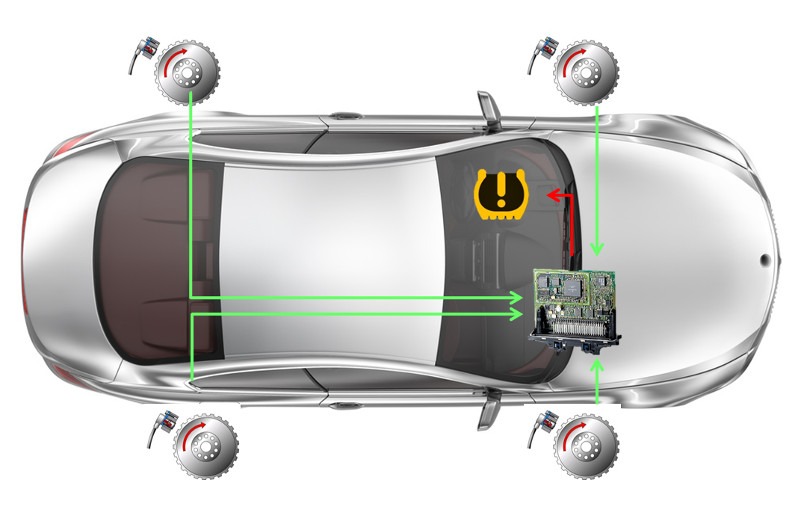Advantages Of Direct Tpms Vs. Indirect Tpms: Which Is Better?
In today’s fast-paced world, where convenience and efficiency reign supreme, technologies that enhance vehicle safety and performance have become integral. One such technology is the Tire Pressure Monitoring System (TPMS), a feature designed to alert drivers about improper tire pressure, reducing the risk of accidents, improving fuel efficiency, and prolonging tire lifespan. There are two primary types of TPMS systems: Direct TPMS and Indirect TPMS. In this article, we delve into the advantages of both systems, aiming to provide a comprehensive comparison that aids drivers in making an informed choice.

Understanding Direct TPMS
Explanation of Direct TPMS Direct TPMS operates on a straightforward principle: sensors are placed within each tire to measure real-time air pressure. These sensors communicate this data to the vehicle’s onboard computer, which alerts the driver if any tire’s pressure falls below the recommended level.
How Direct TPMS Works When a tire’s pressure decreases, the sensor within it sends a signal to the car’s computer. The driver is promptly notified through a dashboard indicator, allowing immediate corrective action. This real-time monitoring ensures that even slight pressure deviations are detected and addressed promptly.
Advantages of Direct TPMS
Accurate and Real-time Tire Pressure Monitoring Direct TPMS provides accurate and instantaneous measurements of each tire’s pressure, enabling drivers to maintain optimal inflation levels. This accuracy contributes significantly to overall vehicle safety.
Individual Tire Pressure Measurement By monitoring each tire separately, direct TPMS allows drivers to identify specific underinflated tires. This precision aids in targeted maintenance, preventing uneven tire wear and potential blowouts.
Enhanced Safety and Responsiveness The immediate alerts provided by direct TPMS ensure that drivers can address tire pressure issues promptly, reducing the risk of accidents caused by underinflated tires. This feature is particularly vital during emergency maneuvers.
Monitoring Spare Tire Pressure Direct TPMS also monitors the spare tire’s pressure, a feature often overlooked. This ensures that even in critical situations, the spare tire is ready for use, enhancing overall road safety.
Reduced Maintenance Time and Costs While the initial installation cost of direct TPMS may be higher, the precise monitoring it offers can lead to reduced maintenance time and costs over the vehicle’s lifespan. Addressing tire pressure issues before they escalate minimizes the need for extensive repairs.
Exploring Indirect TPMS
Explanation of Indirect TPMS Indirect TPMS utilizes the vehicle’s existing systems, such as the Anti-lock Braking System (ABS) or the wheel speed sensors, to monitor tire pressure indirectly. It relies on algorithms to analyze the data and infer potential tire pressure deviations.
How Indirect TPMS Works Indirect TPMS monitors changes in wheel rotational speeds, as underinflated tires have a slightly smaller diameter and must rotate more to cover the same distance. By comparing the rotational speeds of different wheels, the system detects potential pressure issues. To learn more about this topic, click here https://gutatpms.com/.
Advantages of Indirect TPMS
Cost-effectiveness in Terms of Initial Installation Indirect TPMS typically comes pre-installed in many modern vehicles, reducing the need for additional sensors and installation costs. This makes it a cost-effective option for manufacturers and consumers alike.
No Additional Sensors Required for Each Tire Since indirect TPMS utilizes existing vehicle systems, there is no need to install individual sensors in each tire. This simplifies maintenance and reduces the chances of sensor-related failures.
Low Maintenance and Battery Life Concerns Indirect TPMS relies on existing sensors and systems that often have longer lifespans and lower maintenance requirements compared to direct TPMS sensors. This can lead to fewer maintenance hassles and potentially lower long-term costs.
Comparative Analysis: Direct vs. Indirect TPMS
Accuracy and Precision Direct TPMS excels in accuracy, providing real-time data for each tire. In contrast, indirect TPMS relies on algorithms and inferred data, potentially leading to less precise readings.
Safety and Responsiveness Direct TPMS offers immediate alerts, crucial for preventing accidents caused by underinflated tires. Indirect TPMS might have a delayed response or false positives due to its reliance on algorithms.
Maintenance and Costs While direct TPMS might have higher initial installation costs, its accurate monitoring could result in lower maintenance costs over time. Indirect TPMS, on the other hand, benefits from fewer sensor-related issues.
Installation Complexity Direct TPMS requires sensor installation on each tire, adding complexity during initial setup and potential maintenance. Indirect TPMS relies on existing systems, simplifying installation and maintenance.
Real-World Performance and Considerations
Direct TPMS Success Stories Numerous testimonials highlight how direct TPMS prevented accidents by detecting underinflated tires promptly. Additionally, its impact on fuel efficiency and tire lifespan underscores its significance.
Indirect TPMS Practicality Indirect TPMS proves sufficient for everyday drivers, especially those seeking a cost-effective solution. However, factors such as tire rotations and replacements can affect its performance.
Future Trends and Innovations
Advances in Direct TPMS Technology Ongoing research aims to enhance direct TPMS accuracy, sensor durability, and integration with other vehicle systems, making it an even more robust safety feature.
Improvements in Indirect TPMS Algorithms Advancements in algorithms could bolster indirect TPMS’s accuracy and responsiveness, narrowing the gap between direct and indirect systems.
Integration with Other Vehicle Safety Systems Both direct and indirect TPMS could become integral components of broader vehicle safety networks, contributing to more comprehensive accident prevention.
Conclusion
In the direct TPMS vs. indirect TPMS debate, both systems offer distinct advantages. Direct TPMS shines with its accurate real-time monitoring and enhanced safety features. On the other hand, indirect TPMS stands out for its cost-effectiveness and lower maintenance requirements. The choice between the two ultimately depends on individual preferences, driving habits, and the level of precision desired. Regardless of the chosen system, the importance of maintaining optimal tire pressure cannot be overstated, as it remains a critical factor in ensuring vehicle safety, efficiency, and overall performance on the road.


















